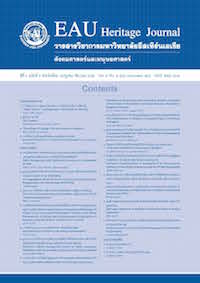รูปแบบการนิเทศการศึกษานอกโรงเรียนสู่การปฏิรูปการเรียนรู้
Keywords:
การนิเทศ, การปฏิรูปการเรียนรู้, supervision, learning reformAbstract
การวิจัยนี้มีวัตถุประสงค์เพื่อ (1) ศึกษาสภาพปัจจุบันและปัญหาการนิเทศการศึกษานอกโรงเรียน (2) สร้าง รูปแบบการนิเทศการศึกษานอกโรงเรียนที่นำไปสู่การปฏิรูปการเรียนรู้ (3) ประเมินรูปแบบการนิเทศการศึกษานอกโรงเรียน ที่นำไปสู่การปฏิรูปการเรียนรู้ กลุ่มตัวอย่างได้แก่ บุคลากรของศูนย์ กศน.เขต จำนวน 346 คน ผู้รับการนิเทศ จำนวน 190 คน ผู้ให้การนิเทศ จำนวน 104 คน ผู้นิเทศภายใน จำนวน 20 คน เครื่องมือที่ใช้ในการวิจัยประกอบด้วย (1) แบบสอบถาม (2) แบบสัมภาษณ์ศูนย์ (3) แบบประเมินความสอดคล้องเหมาะสมของรูปแบบการนิเทศการศึกษา นอกโรงเรียนสู่การปฏิรูปการเรียนรู้ โดยผู้เชี่ยวชาญที่เป็นผู้นิเทศภายใน จำนวน 32 คน การวิเคราะห์ข้อมูลใช้วิธีการ วิเคราะห์เอกสาร การหาค่าร้อยละ ค่าเฉลี่ย ค่าเบี่ยงเบนมาตรฐาน ค่ามัธยฐาน ค่าฐานนิยม ค่าความแตกต่างระหว่าง มัธยฐานกับฐานนิยม และค่าพิสัยระหว่างควอไทล์ ผลการวิจัยได้รูปแบบการนิเทศการศึกษานอกโรงเรียนสู่การปฏิรูป การเรียนรู้ ทำการตรวจสอบความถูกต้องและความเป็นไปได้ด้านเนื้อหา โดยผู้เชี่ยวชาญ และประเมินรูปแบบเพื่อศึกษา ความชัดเจน ความเป็นไปได้ในการนำไปปฏิบัติ และเพื่อรับรองรูปแบบการนิเทศการศึกษานอกโรงเรียนสู่การปฏิรูป การเรียนรู้ โดยวิธีการจัดประชุมและการสนทนากลุ่ม ประกอบด้วย องค์ประกอบ 3 ส่วน จำแนกออกเป็น วิธีการนิเทศ และกระบวนการนิเทศ ที่ต้องดำเนินการควบคู่กันให้ครบทั้ง 3 องค์ประกอบ ได้แก่ (1) วิธีการนิเทศแบบเคียงคู่ (2) วิธีการนิเทศแบบต่อเนื่องไม่รู้จบ (3) กระบวนการนิเทศแบบครบวงจรการนิเทศ
The Non-Formal and Informal Education Supervision Model Toward Learning Reform
The research presents the development of non-formal and informal education supervision model toward learning reform. There were three processes in the research: (1) Study of non-formal and informal education supervision’s problem; (2) Create of non-formal and informal education supervision model towards learning reform; (3) Present and assure on non-formal and informal education supervision model towards learning reform.
The sample consisted of 346 officials, non-officials, and non-formal and informal education teachers from 40 district administrators of non-formal and informal education centers by purposive selection. There were three research tools: (1) Questionnaires for studying non-formal and informal education supervision which are divided in two sets. Set 1 is a questionnaire for those supervised as informal education teachers. Set 2 is a questionnaire for supervisors as directors, officials, and nonofficials; (2) Interviews with the directors who managed a progressive and successful non-formal and informal education center; (3) Evaluation of a related non-formal and informal education supervision model towards learning reform. Document between median and mode, and interquartile.
The findings reveal that there were two methods and four processes in the development of the non-formal and informal education supervision model toward learning reform and must be completed in three elements: (1) Peer supervision; (2) Continuously supervision;(3) Completely four processes supervision which is called perfect continuously peer supervision. Peer supervision must be processed in two characteristics: (1) Supervise between management and activities; (2) Supervise between inner and outer. Continuously supervision is non-official teachers from non-formal and informal education center must receive every activity continuously. Perfect supervision consists of four processes: (1) Preparing ;(2) Operating ;(3) Summarizing ;(4) Presenting.





